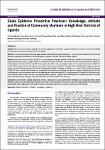| dc.contributor.author | Kigongo*, Eustes | |
| dc.contributor.author | Auma, Ann Grace | |
| dc.contributor.author | Tumwesigye, Raymond | |
| dc.contributor.author | Namukwana, Beth | |
| dc.contributor.author | Musinguzi, Marvin | |
| dc.contributor.author | Okalo, Ponsiano | |
| dc.contributor.author | Kambugu, Caroline Nabasiry | |
| dc.contributor.author | Kabunga, Amir | |
| dc.date.accessioned | 2023-05-29T07:34:53Z | |
| dc.date.available | 2023-05-29T07:34:53Z | |
| dc.date.issued | 2023 | |
| dc.identifier.citation | Kigongo, E., Auma, A.G., Tumwesigye, R., Namukwana, B., Musinguzi, M., Okalo, P., Kambugu, C.N., and Amir Kabunga. (2023). Ebola Epidemic Preventive Practices: Knowledge, Attitude and Practice of Community Members in High-Risk Districts of Uganda. Journal of Infectious Diseases and Medicine | en_US |
| dc.identifier.issn | ISSN: 2576-1420 | |
| dc.identifier.uri | http://ir.lirauni.ac.ug/xmlui/handle/123456789/706 | |
| dc.description.abstract | Background: As part of the country's ongoing EVD outbreak preparedness activities in Uganda, our goal was to evaluate community knowledge
and attitudes and preventive practices linked to the disease.
Methods: This study employed a community-based cores sectional study among 842 participants. The study was conducted in three districts of
Mubende, Kyegegwa and Kassanda in the central region of Uganda. These are high-risk districts in Uganda
Results: Results show that the majority 290(34.4%) of the participants were aged between 28–38 years, 578(68.6%) were female, 482(57.2%)
had primary education, 431(51.2) single, 369(44.7) unemployed and 196(23.8) received information from radios. Results indicate that 821(97.5%)
of the participants had heard of EVD, and 646(76.7%) reported that EVD is a rare and deadly disease. On the mode of transmission, 562(66.7%)
knew that EVD is transmitted through physical contact with an infected person, 498(59.1%) through blood and 606(72.0%) through normal social
contact. Overall, 525 respondents were classified as having good knowledge of the Ebola virus disease, accounting for 62.4% of the total, whereas
470(55.8%) had a favorable attitude toward the management and prevention of the Ebola virus disease. A greater understanding of the Ebola
virus disease was found among participants with increased age and education beyond the first grade compared to those with no formal education.
Casual labourers were 3 times more likely to have good practices compared to agriculturalists. Participants who received information from others
sources were less likely to have good practices compared to those who received it from the radio.
Conclusion: Communities in Uganda impacted by filovirus outbreaks have a reasonable level of knowledge and a favourable attitude toward
methods to prevent and control the Ebola disease. Public health officials should do more by providing instructional materials for future epidemic
preparedness utilizing appropriate communication channels, especially, including local radios as reported by the communities.
Keywords: Attitude • Ebola virus • Infection • Knowledge • Prevention | en_US |
| dc.language.iso | en | en_US |
| dc.publisher | Journal of Infectious Diseases and Medicine | en_US |
| dc.subject | Attitude | en_US |
| dc.subject | Ebola virus | en_US |
| dc.subject | Infection | en_US |
| dc.subject | Knowledge | en_US |
| dc.subject | Prevention | en_US |
| dc.title | Ebola Epidemic Preventive Practices: Knowledge, Attitude and Practice of Community Members in High-Risk Districts of Uganda | en_US |
| dc.type | Article | en_US |

